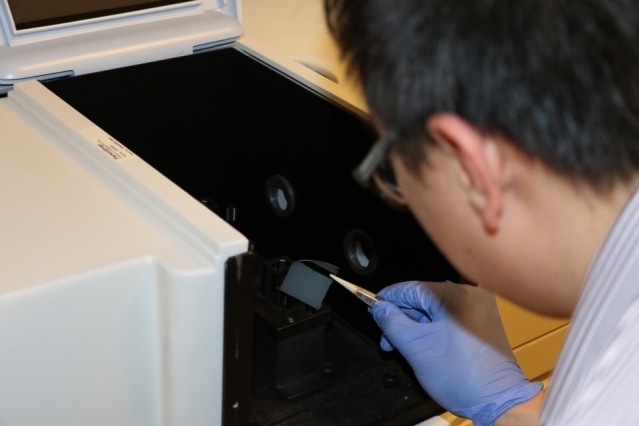Jun 14 2016
Researchers from the Masdar Institute of Science and Technology and MIT have developed a device, called a solar absorber, which can be used to convert solar energy into heat, in increased amounts and in a cost-efficient manner. Due to this development, the sustainable technologies that utilize solar heat to function would benefit a lot as it can make them more affordable and efficient.
 By patterning a solar absorber with tiny holes with diameters less than 400 nanometers, an MIT-Masdar Institute team has enhanced the range of solar energy that the device can absorb. Here, Masdar Institute postdoc Jin You Lu characterizes the nanoporous solar absorber using UV-Vis-NIR spectroscopy. Photo: Tahra Al Hammadi/Masdar Institute News
By patterning a solar absorber with tiny holes with diameters less than 400 nanometers, an MIT-Masdar Institute team has enhanced the range of solar energy that the device can absorb. Here, Masdar Institute postdoc Jin You Lu characterizes the nanoporous solar absorber using UV-Vis-NIR spectroscopy. Photo: Tahra Al Hammadi/Masdar Institute News
“Our research team has developed a simple and cost-effective fabrication technique to create solar absorbers that can harness a greater share of the solar spectrum, thus increasing their efficiencies, while also maintaining low emission levels,” says TieJun Zhang, assistant professor of mechanical and materials engineering at the Masdar Institute, a graduate-level engineering university in the United Arab Emirates.
The paper, which has been co-authored by Zhang, detailing the work of this research team was published in the journal, Advanced Optical Materials in the June 2016 issue. The team's development would aid a much bigger project, conducted by Masdar Institute and MIT, which is intent on developing a cooling system and electrical power plant powered by solar energy.
In 2007, the Masdar Institute was launched by the MIT and Masdar Institute Cooperative Program. Both the institutions collaborate on research projects that deal with issues regarding global energy and sustainability. These research studies are conducted in order to increase development and research potential in Abu Dhabi.
We are very excited that this MIT-Masdar Institute collaboration has led to new insights in the emerging field of plasmonics, which quantifies the interactions between the electromagnetic field and free electrons in a metal. By trapping sunlight with plasmonics, the solar absorber developed by our team can achieve higher efficiency levels. We look forward to testing the overall solar conversion efficiency of the coating materials in the next step of our research.
Nicholas X. Fang, Professor of Mechanical Engineering, MIT
The research team has developed a unique fabrication technique, which involves designing a solar absorber comprising extremely tiny holes, with a diameter less than 400 nm - approximately 1/200 the width of a strand human hair - cut into the absorber at uniform intervals.
These holes that pass through the surface of the absorber considerably improve the amount of solar energy that is absorbed. The device absorbs nearly 90% of the light wavelengths that hits the earth's surface. This solar absorber, unlike the conventional ones, has only two layers and needs considerably less material. Of these two layers, one is a metallic and reflective and the other is a semiconductor film. The combined thickness of both the layers comes up to only 170 nm.
This idea can be applied to most conventional solar absorbers. With this unique patterning, the absorbers can be boosted to harvest more solar energy from the ultraviolet and visible regions of the electromagnetic spectrum.
Jin You Lu, Postdoc, Masdar Institute
By maximizing the solar absorption and minimizing the thermal heat radiation, the efficiency of a solar absorber can be optimized. It is a challenging task to develop a solar absorber that is capable of absorbing high levels of sunlight and at the same time keeping a check on thermal radiation losses. The more energy absorbed by the solar absorber, the more the temperature of the absorber increases, which leads to loss of energy in the form of thermal radiation.
Lu believes that the researchers may have found a solar absorber‘s sweet spot, which is considered to be that situation when the maximum amount of sunlight is absorbed with minimum loss of energy into the atmosphere in the form of radiation.
By taking advantage of the ultrathin film coatings and patterning, we are able to maximize the absorption spectrum while keeping the solar absorber’s emission levels quite low.
Jin You Lu, Postdoc, Masdar Institute
The team is currently engaged in optimizing the system by using metals such as copper, silver, or aluminum as the reflective metallic surface, which would further reduce the cost of solar absorbers.